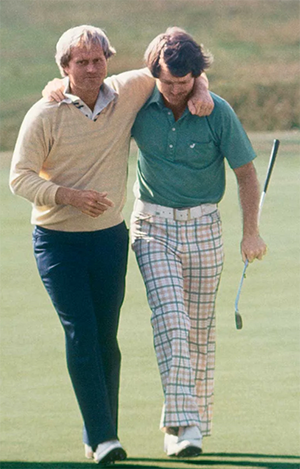Dominating The Decades – The Fight And Focus Of Tom Watson
By Rhett Arens
The 80’s decade represented a changing of the guard at the top of golf’s leaderboards. The previous two decades were dominated by Arnie’s Army and then the Golden Bear. Sure, there were others making headlines and certainly there is not a clean break at the decades start and finish, but Tom Watson started things off in the early 1980’s with a bang. His reputation as a world beater was secured with consistent dominance across the pond in The British Open Championships. An appreciation for his tenacity, iron play and short game excellence played well in the coastal winds and tall dunes of Great Britain’s toughest courses. His humble words and nimble interviews at the podium while holding the Claret Jug didn’t hurt his popularity either. Admiring galleries of golf savvy, rain-soaked, extremely polite spectators nodded in approval.
Like many professional golfers before and after, young Tom was introduced to the game by his father. On the fairways and greens around Kansas City, Missouri, the two of them played and often competed with each other. Tom’s dedication and maturity paid off as he morphed into a dominate high school player at Pembroke. He went on to win four Missouri State Amateur Championships before attending Stanford and graduating with a degree in psychology. I’m not trying to read too much into that choice of college major, but he did have a reputation as an iceman and could easily out-stare opponents down the stretch… a nice skill to have in your PGA toolkit. Like many of us, he eventually settled down in his retirement years close to where we grew up. Today he makes his home back in Overland Park within easy driving distance of those same courses he and his father played in and around the Kansas City area.
The last half of the 1970’s saw Tom picking his opportunities and cashing them in. He was constantly in Jack’s rearview mirror and managed to blow by him through four Major Tournaments and 13 PGA TOUR events in the late 1970’s. So winning was nothing new for ‘Huck’ (mercifully short for his tongue-in-cheek nickname – Huckleberry Dillinger) as he approached the 1980’s. He entered the 80’s and promptly proceeded to dominate the first year of the decade with winnings topping $500,000 for the first time in golf history with seven PGA TOUR wins. He also logged 16 top-ten finishes and then capped the year off by winning The British Open Championship at Muirfield by four strokes. That in itself would have been an admirable decade for golf’s upper-tier players, but that was only one year’s worth of work for a digger like Tom!
The next year saw him winning The Masters at Jack’s expense by two strokes which meant he was now focused on adding the U.S. Open trophy to his mantle of Major wins. In 1982 he finally got his chance when his short game triumphed in what is considered the best shot in golf history (by ESPN anyway) when he hit the flag with a green-side chip, jarring a birdie on the par 3 17th at Pebble Beach. This allowed him to keep the roaring Golden Bear subdued once again as Tom also went on to birdie the 18th and seal-the-deal.
It’s not likely that the founders of the game envisioned a Yank dominating The British Open when they conceived of the tournament back in the 1860’s. The upside for the European players witnessing Watson’s five British Open Championship titles was in a word – globalization. All industries go through it and the Sergios, Henriks, Rorys and Tommys playing today can thank both Mr. Watson and Tiger for the types of purses they chase in the U.S. market. Old Huck was a bridge builder and an ambassador that catalyzed international participation from the U.S. while Seve carried that torch in Europe. Watson’s 21 wins in the 1980’s would go a long way towards growing the game globally not to mention his admired style of keeping his head down, all business, in all weather, all the time. The smiles came at the trophy ceremonies and that was what won the hearts of the next generation of players. He would see one more chance to share his steely game and thrill the European crowds at the incredible age of 59 when he made his unprecedented run at the 2009 British Open Championship title. The playoff between him and Stewart Cink did not have the type of Hollywood ending most were hoping for as Tom’s 59 year-old body and a 76-hole fatigue set-in during those last four playoff holes. But his best achievement may have been in how he accepted that loss with humility and humor. Keep in mind this was done against the backdrop of the rising tide of prima donna, private jet, personal trainer, sponsor driven, agent coached, occasionally cheating (yes, you Reed) players of today.
Given his dominance in the 1980’s, it’s not surprising he was named Player of the Year three times during the decade (’80, ’82 and ’84). He didn’t have to wait long for his Hall of Fame induction either with that honor coming in 1988. There were many honors and awards that followed as Tom’s career wound down in the 1990’s and into the 2000’s on the PGA TOUR Champions where he pocketed 9 wins. As competitive as he was and as respected as he was in Europe, the Ryder Cup wins in 1993 and 2014 as captain must have felt good. He played on four Ryder Cup teams between ’77 and ’89 setting the standard for focused play. He was honored with the Bob Jones Award in 1987 by the USGA for his distinguished sportsmanship. A few other fun facts related to Tom’s longevity and commitment to good health include the fact that he was the oldest player in Masters history to shoot under par (in 2015 at age 65), the oldest to win the Masters Par-3 Contest (age 68) and of course, the oldest to lead The British Open after regulation play in 2009 (at age 59).
Tom’s amiable but no-nonsense playing style is a blueprint for overachievers everywhere. Small in stature and large in heart is a great combination for success in the game of golf. The tall guys have some extra leverage and a bit more muscle, but there is always a smart way around that. Think well placed irons, keep-it-in-play club selection, or low-drive roll-outs that keep the ball where it belongs. There is the short game that requires thousands of hours of dedication and a surgeon’s touch under pressure. The putter needs to cooperate and when it doesn’t, it takes clear focus to work around it (and possibly a psychology degree). You add up all these pillars of the game and you have dominance. You have Tom Watson in the 1980’s.

Tom Watson with Jack Nicklaus during the 1977 British Open which he won by one stroke







